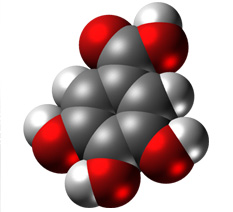







Gallic acid molecule
Gallic acid (3,4,5-trihydroxybenzoate) is a trihydroxybenzoic acid, a type of phenolic acid, a type of organic acid, also known as 3,4,5-trihydroxybenzoic acid, found in gallnuts, sumac, witch hazel, tea leaves, oak bark, and other plants.
Gallic acid has been isolated and identified as a tyrosinase inhibitor from many plants, and its inhibitory mechanism together with those of its ester derivatives has been well studied.
It has been found that gallic acid inhibited diphenolase activity of mushroom tyrosinase with a IC50 value of 4500 μM, which is 100-fold lower than that of kojic acid. In addition, gallic acid itself and its short alkyl chain esters (<C10) were oxidized by mushroom tyrosinase as substrates, but the long-chain alkyl chain esters (>C10) inhibited the enzyme without being oxidized. Gallic acid was also found to be very toxic to melanoma cells with cytotoxicity comparable to that of hydroquinone. Recently, Nithitanakool et al. isolated both gallic acid and its methyl derivative from seed kernels of Mangifera indica, and determined that both compounds were poor inhibitors against diphenolase activity of mushroom tyrosinase with 300- and 30-fold, respectively, lower activity than that of kojic acid. These results were consistent with previous studies.
In spite of the poor inhibitory activity of gallic acid itself, some compounds with gallate moiety were found to inhibit mushroom tyrosinase more effectively. Various gallic acid derivatives of hydroxyflavanols had been isolated from green tea and Galla rhois, and some of them were identified as strong tyrosinase inhibitors(63-65).
Gallic acid and its short alkyl (<C10) chain esters were oxidized by tyrosinase as substrates, yielding yellow oxidation products, but the long alkyl (>C10) chain esters inhibited the enzyme without producing the pigmented products, indicating that the carbon chain length was related to their tyrosinase inhibitory activity(64,66-68). The most abundant hydroxyflavanols in green tea included ECG [(-)epicatechin-3-O-gallate], GCG [(-)gallocatechin-3-O-gallate], EGCG [(-)epigallocatechin-3-O-gallate], and EGC [(-)epigallocatechin]. It was reported that EGCG and hinokitiol (structurally not related to hydroxyflavanols) were not only tyrosinase inhibitors, but also agents that decreased MITF production in cells. Similarly, three tyrosyl gallates were synthesized and showed stronger inhibitory activity.
In recent times, 1,2,3,4,6-pentagalloylglucopyranose isolated from the seed kernels of M. indica and the roots of Paeonia suffruticosa, respectively, was found to be 16-fold more active than gallic acid and inhibited monophenolase activity of mushroom tyrosinase with a non-competitive mode.
>
>
>
>
>
>
>
>
>
>
>
>
>
>
>
>
>
>
>
>
>
>
>
>
>
>
>
>
>
>
>
>
>
>
>
>
>
>
>
>
>
>
>
>
>
>
>
>
>
>
>
TOP 20
Hydroquinone
Monobenzyl Ether of Hydroquinone
Azelaic Acid
Kojic Acid
Arbutin
Retinoids
Mequinol
Niacinamide
Soy
Vitamin C
Corticosteroids
Licorice
Hydroxystilbene
Aloesin
Glutathione
Glycolic Acid
N Acetyl Glucosamine
Gentisic Acid
Green Tea
Melatonin
SKIN WHITENING AGENTS A-Z
a-Hydroxyacids
Aloesin
Alpha Tocopherol and Alpha Tocopherol Ferulate
Arbutin
Azelaic Acid
Centaureidin and Methylophiopogonanone B
Gallic Acid and Derivatives
Gingko
Ginseng
Glutathione
Glycolic Acid
Green Tea
Hesperidin
Hydroquinone
Hydroxycinnamic Acid and Derivatives
Hydroxystilbene
Kojic Acid
Licorice
Linoleic Acid
Magnesium Ascorbyl Phosphate
Melatonin
Mequinol
Monobenzyl Ether of Hydroquinone
Mulberry
N Acetyl Glucosamine
N-Acetyl-4-S-Cysteminylphenol
Niacinamide
Retinoids
Salicylic Acid
Soy
Vitamin C

<< Previous: Centaureidin and Methylophiopogonanone B
Next: Gingko >>